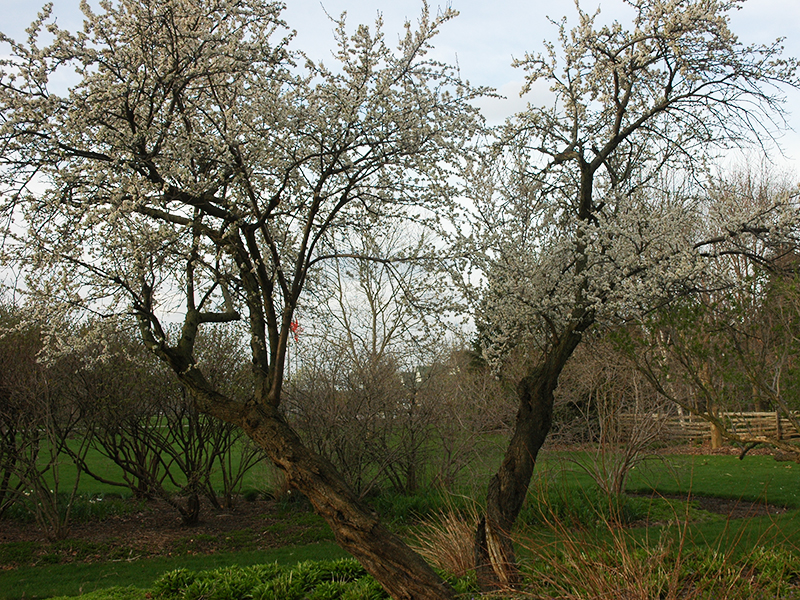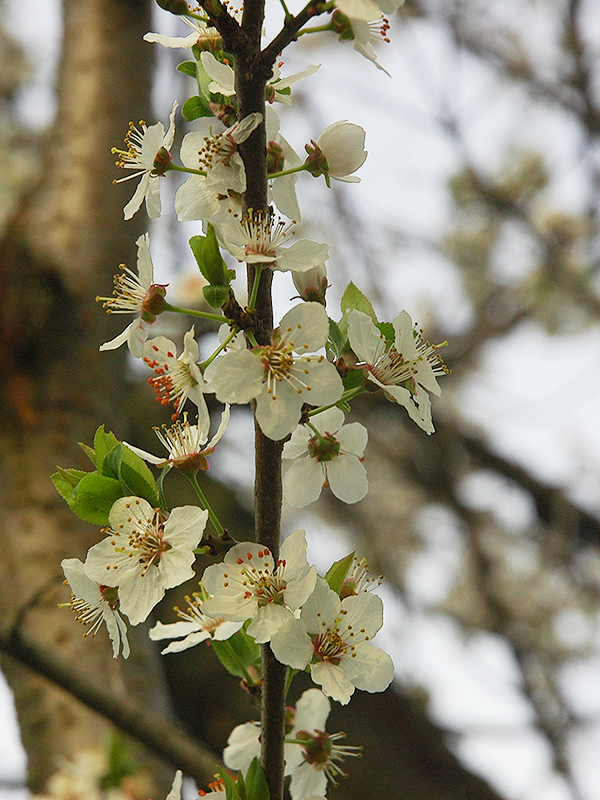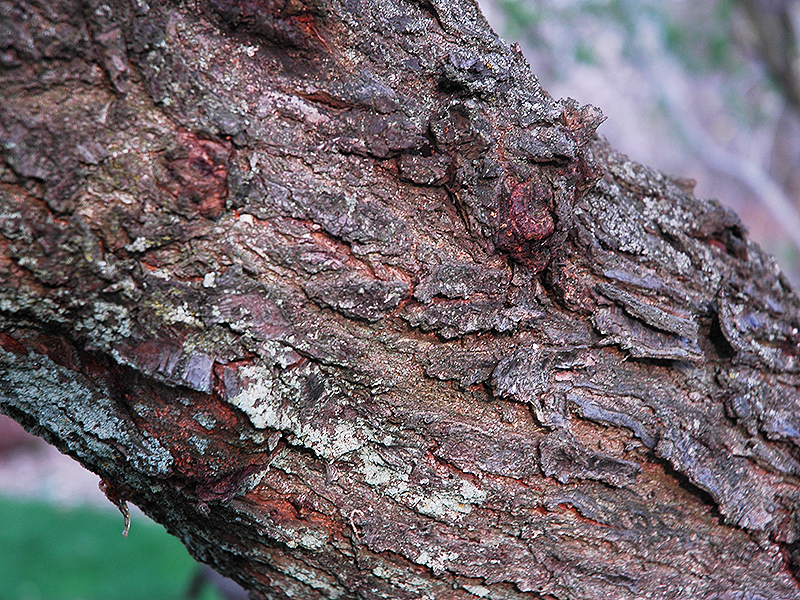
Woody > Prunus > Prunus americana > Prunus americana
Prunus americana
American Plum
Origin: North America, ranges from Saskatchewan to southern parts of Quebec and south through the southern reach of the Carolinian Zone.
Mike's
Opinion


"
P. americana is an often overlooked native species which can offer an excellent addition to urban or rural landscapes due to its texture and colour from spring through winter. It can be enveloped in a mass of showy white flowers in early spring and become a draw for wildlife as the fruit matures. While other species and cultivars of plum have been chosen for enhanced fruit value, the fruit and other parts the plants of Prunus americana, such as the leaves can be used to make a green dye. Additionally the inner bark of P. americana may be made into a poultice to disinfect cuts and wounds.
Michael Pascoe, NDP., ODH., CLT., MSc. (Plant Conservation)
"
| Family |
| Rosaceae |
| Genus |
| Prunus |
| Species |
| americana |
| Category |
| Woody |
| Type |
| Tree (deciduous) |
| Pronunciation |
| USDA Hardiness Zone |
| 3 - 8 |
| Canadian Hardiness Zone |
| 1a - 8a |
| RHS Hardiness Zone |
| H7 - H4 |
| Temperature (°C) |
| (-37) - (-7) |
| Temperature (°F) |
| (-35) - 20 |
| Height |
| 4.5-7.5 m |
| Spread |
| 4.5-7.5 m |
Photographs
Description and Growing Information
Flowering Period
| General Description |
| Small upright single or multi stemmed tree with rounded shape. Slightly smooth bark when immature which becomes scaly with age. Leaves are obovate to oblong-ovate 5-10 cm in length, with a slight pubescence on the underside. Dark green leaves throughout growing season and red or yellow fruit in autumn. |
| Landscape |
| In single stem form it can be used as a landscape plant that will add winter interest with its long fine branching and in spring with showy flowers. Additionally it can be used as a windbreak or screen since it can be grown close together and pruned to form a thicket. |
| Cultivation |
| Full sun to partial shade. Highly adaptable in loam to clay soils and can handle a range in pH from 5.5-7.5. |
| Shape |
| Can form a single or multi stemmed tree, with a rounded crown. |
| Growth |
| Fast |
| ID Characteristic |
| Small deciduous tree with dark green alternate, obovate to oblong-ovate leaves with a pale underside. Double serrate margins with slight pubescence on top and along midrib. White 5 petaled single flower or in umbels of up to 5, opening in early spring before the tree leafs out, maturing to a globular 2.5 cm, red or yellow fruit in autumn. |
| Pests |
| Plum curculio and black knot are common, but not serious diseases. Plum Pox: Symptoms may be confused with other diseases/disorders such as nutrient deficiencies or pesticide injuries. PPV symptoms can occur on leaves, flowers and/or fruit. Faint yellow rings or lines may be found on the leaves. PPV generally does not cause plant mortality however, can reduce the plant productivity and longevity. How to Reduce the Spread and Impact of PPV: 1. Propagate vulnerable Prunus trees and shrubs outside of the affected area a. Isolation is important to protect clean plants from future spread of the disease. b. Propagating and growing vulnerable plants away from the virus-infected area reduce the likelihood of the disease spreading any further. This should be as far away from the quarantined area and any potential sources of the virus. 2. Propagate Prunus plants with virus-free Budwood and Rootstock from virus tested mother trees a. This eliminates the propagation link for viral diseases. 3. Inspect vulnerable Prunus for symptoms a. All Prunus shrubs and trees should be visually inspected for symptoms at lease twice per year and conducted by trained personnel familiar with the virus. b. Any plants found to be infected should not be moved or sold and must be reported to the Canadian Food Inspection Agency immediately. c. Inspections should not be conducted in periods of hot weather (temperatures over 30˚C). 4. Manage aphid vectors a. Aphids are extremely attracted to suckers (vegetative shoots at the base of the tree), these should be removed to avoid aphid colonization, feeding or migration. 5. Plant tolerant and resistant varieties a. When available, grow plum pox tolerant or resistant Prunus varieties. |
| Habitat |
| Found from the eastern edge of the Rocky Mountains to the east coast of North America. Due to the adaptability of P. americana, it can be found in many different areas, from dry fields to moist forest understory. It is condisered a succession plant and is rarely found in climax forests. It can spread quickly through underground roots which can emerge up to 3 m from the parent plant helping to quickly form dense thickets. Most often found in disturbed sites. |
| Bark/Stem Description |
| The bark can vary slightly from region to region, from a dark reddish-brown to a grayish colour. As the tree ages the bark becomes scaly and pronounced. Small gray lenticels almost circular on young bark elongate with age. |
| Flower/Leaf Bud Description |
| The buds are alternate, brown to dark brown and 3-6 mm long. |
| Leaf Description |
| The leaves are alternate, simple, double serrate. Obovate to oblong-ovate, 5-10 cm in length. Dark green on top and slightly pubescent and pubescent on the pale underside. |
| Flower Description |
| Showy white, 5 petaled flowers emerge from the leaf axil in early spring before the leaves. The flowers can be single or in umbels of 2-5 flowers, and are 2.5 cm wide which can remain for up to 14 days. |
| Fruit Description |
| Immature drupes are dull green while forming turning red or yellow and are 2.5 cm in diameter in the autumn. Exocarp can be tough and sour, with a single large seed. Mesocarp can be sweet and can be eaten fresh or used for a variety of culinary purposes such as pies and preserves. |
| Colour Description |
| Dark green foliage changing to yellow and reddish in autumn. It has white flowers in early spring. As the fruit develops it is a dull mid-green colour, ripening to red or yellow. The bark can range from reddish-brown to grayish in young growth but darkens with age. |
| Texture Description |
| Slightly coarse when young, becoming very coarse with age. |
| Notable Specimens |
| The A.M. Cuddy Gardens, Strathroy, Ontario, Canada. |
| Propagation |
| Grown from seed, it requires a long stratification period in a moist environment ranging between 60-150 days at 10 C°. Once established it is easy to transplant and requires rich, moist soil. Often used as rootstock for ornamental trees, P. americana is very difficult to grow from cuttings, some success may occur using softwood cuttings in spring or early summer. |
References
"American Plum." AG.NDSU.edu. North Dakota State University Agriculture, 3 Feb. 1999. Web. 20 Nov. 2012.
Fryer, Janet L. "Prunus Americana." Fs.fed.us Department of Agriculture, Forest Service, 2010. Web. 21 Nov. 2012.


